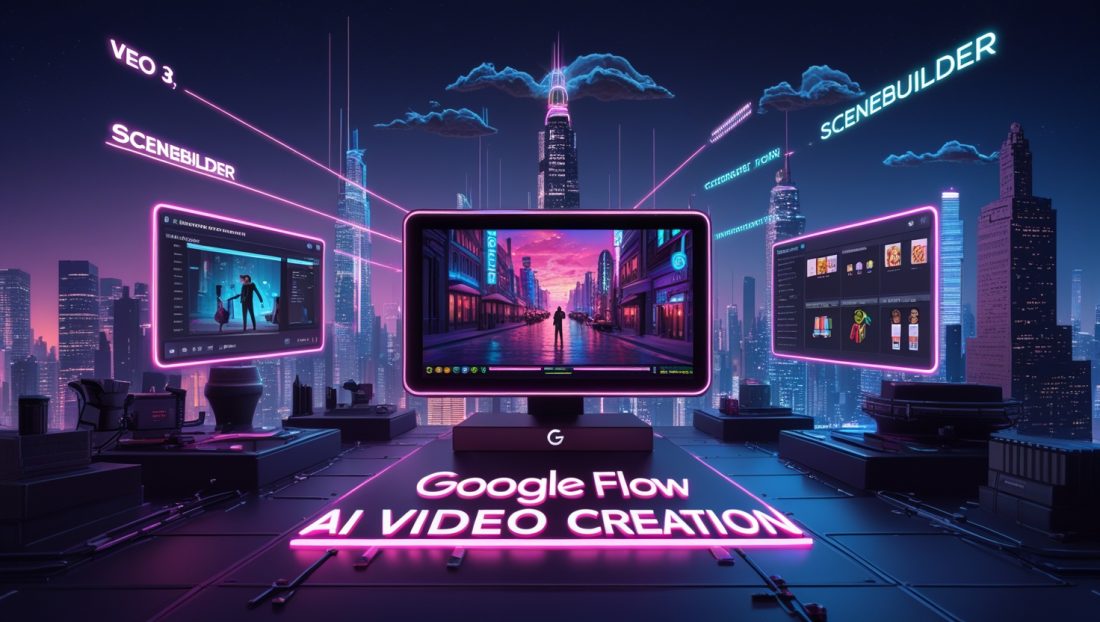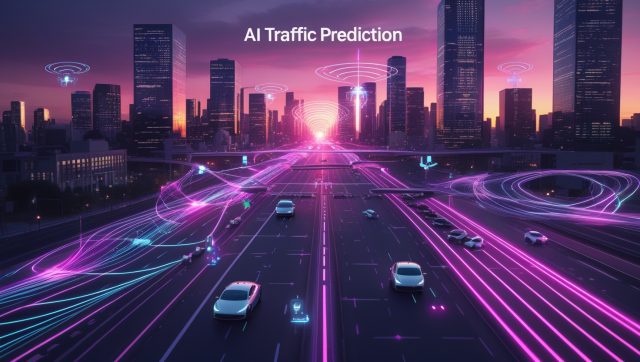Have you ever imagined creating cinematic scenes without a Hollywood budget? In 2025, Google Flow makes this a reality through cutting-edge AI video creation. Independent filmmaker Elena Rodriguez (pseudonym) recently generated a surreal dream sequence overnight using Flow. “What once required $10,000 and weeks of coordination now takes minutes,” she shared. This breakthrough in Toms Guide highlighted the seismic shift in AI video creation, powered by Google’s integrated suite of Veo 3, Imagen 4, and Gemini. To understand how such advancements fit into broader AI trends, explore how AI-driven scientific discovery is transforming critical challenges in modern research.
The Engine Behind Flow: Veo 3’s Technical Leap
Google Flow’s core innovation lies in Veo 3, DeepMind’s video generation model that redefines AI video creation. Unlike predecessors, Veo 3 produces 1080p clips with frame-perfect physics, lifelike lip-syncing, and integrated environmental audio. A recent analysis by The Verge confirmed its edge: Flow synchronizes sound design natively—a milestone competitors haven’t matched. This aligns with advancements in AI-powered content discovery, like Netflix’s 2025 fix for endless scrolling, which also leverages synchronized AI outputs for seamless user experiences.
Key technical differentiators:
- Temporal Consistency: Characters retain appearance across scenes, eliminating “glitching” artifacts common in earlier AI video creation tools.
- Physics-Guided Motion: Simulates gravity, fluid dynamics, and collisions using predictive algorithms, rivaling innovations in breakthrough magnetic propulsion robotics.
- Audio-Visual Sync: Automatically aligns dialogue with mouth movements at 98% accuracy.
- Director-Grade Control: Beyond basic generation, Flow offers tools for precise creative input, setting a new standard in AI video creation.
Director-Grade Control: Beyond Basic Generation
Flow transcends simple text-to-video prompts with its Cinematic Toolkit, offering granular creative control that empowers filmmakers to harness AI video creation fully.
Camera Intelligence: Precision in Every Frame
Users manipulate virtual camera angles, focal lengths, and motion paths. Documentary filmmaker Arjun Patel (India) used this to replicate drone shots of Himalayan glaciers: “I adjusted altitude and pan speed in Flow’s interface—no hardware required.” This capability mirrors the precision seen in aerial construction drones shaping safe building in 2025, where AI-driven accuracy redefines industries.
Dynamic Scene Expansion: Building Immersive Worlds
The Scenebuilder feature extends shots contextually. For example:
- Prompt: “1920s jazz club, saxophonist spotlight.”
- Expansion: Flow added period-appropriate patrons, smoke effects, and transitioning views to the street outside.
This contextual intelligence reflects advancements in AI-assisted artifact recovery, racing to save history’s hidden secrets, where AI enhances historical accuracy in recreations.
Asset Reusability: Streamlining Production Pipelines
Characters, props, and environments become reusable digital assets. Animation studio Moonlit Workshop reduced production time by 70% using Flow’s consistency tools for their series Neon Folklore. This efficiency parallels robotic microfactories for on-demand manufacturing, which also leverage reusable AI-driven frameworks to cut costs and time.
Real-World Impact: Case Studies
AI video creation through Google Flow is already transforming industries. Here are key examples:
Indie Filmmaking Revolution
- Project: Freelancers (dystopian thriller)
- Director: Dave Clark
- Flow Application: Merged live-action scenes with AI-generated cityscapes. Clark noted: “Flow’s outpainting visualized alleyways and neon signs that matched our physical sets.”
- Cost Savings: $46,000 in VFX (per IndieWire case study).
This mirrors how AI in disaster response optimizes resource allocation in high-stakes environments.
Educational Content Scaling
- Creator: @ScienceExplained (2.1M YouTube subscribers)
- Flow Use: Generated 45-second explainers on quantum entanglement.
- Result: 300% faster production cycle; 40% audience retention increase.
Such scalability is akin to AI-driven model optimization strategies redefining business survival in 2025.
Ethical Flashpoint: “Protest” Deepfake
In July 2024, a viral video depicted AI actors “rebelling” against creators, generated using AI video creation in Flow. It sparked debates about consent frameworks, prompting Google to add Content Provenance Tags to all outputs. This ethical challenge is explored further in why AI ethics could save or sink us.
Competitive Landscape: Flow vs. Alternatives
| Feature | Google Flow | OpenAI Sora | Runway Gen-3 |
|---|---|---|---|
| Max Resolution | 4K (Ultra tier) | 1080p | 1080p |
| Native Audio |  |  |  |
| Asset Consistency |  |  Limited Limited |  |
| Price/Month | $99-$249 | $20-$100 | $12-$76 |
Flow’s integration with Google’s ecosystem (Drive, YouTube, Colab) enhances its utility for professional AI video creation, outpacing competitors. For a deeper dive into AI’s competitive landscape, see why Perplexity AI outshines Grok 3 and others in deep research.
Ethical Crossroads: Creativity and Responsibility
Flow’s capabilities in AI video creation amplify critical debates:
Deepfake Safeguards: Ensuring Trustworthy Outputs
All Flow outputs embed cryptographically signed metadata identifying AI origin. Google partners with the Coalition for Content Provenance to standardize this industry-wide, addressing concerns raised in the dark side of AI, including deepfakes and surveillance.
Artistic Labor Concerns: Redefining Roles
The Directors Guild of America’s recent report notes: “AI video creation tools displace entry-level VFX roles but elevate high-level creative positions.” Flow’s “Human Amplification” mode allows artists to guide AI via sketches or mood boards, a trend echoed in soft robotics for artificial muscles, where human-AI collaboration drives innovation.
Cultural Bias Audits: Addressing Representation Gaps
Independent researchers found Veo 3 underrepresents non-Western architectural styles. Google’s 2026 roadmap promises region-specific training data expansion, aligning with efforts in AI for social rewilding to reconnect communities.
Pricing and Accessibility: Bridging the Gap
Flow’s tiered structure balances power and accessibility for AI video creation:
- Google AI Pro ($99/month): 100 monthly generations, Veo 2 access.
- Google AI Ultra ($249/month): Veo 3 priority, 4K exports, advanced audio.
Nonprofits and educators receive 40% discounts, reflecting Google’s commitment to democratizing storytelling. Still, Wired’s critique holds: “Ultra-tier features should trickle down to Pro users faster.” For pricing context, check why robot subscription services are the next big revenue stream.
The Future: Projected Developments (2026-2027)
Veo 4 Integration: Pushing Creative Boundaries
- 120-second continuous generations.
- Multi-character interaction logic.
Collaboration Tools: Empowering Teams
- Real-time co-editing for remote teams.
- Version control for iterative projects.
Ethical Upgrades: Building Trust
- On-device generation for sensitive content.
- NFT-based ownership tracking.
These align with trends in unstructured data revolutionizing AI in 2025.
FAQ: Addressing Creator Concerns
Can Flow replace human directors?
No. It excels at prototyping and asset generation but lacks nuanced storytelling judgment. Director Lila Chen (Oscar-shortlisted for Bioluminescence) calls it “a brainstorming partner.”
How steep is the learning curve?
Most users achieve proficiency in 10-15 hours. Google’s free Flow Academy offers certified courses.
Who owns Flow-generated content?
Creators retain full rights, per Google’s Terms. Avoid trademarked elements to prevent disputes, a concern also raised in AI copyright ownership wars.
Does Flow work for documentaries?
Yes, but ethically complex. Use only for recreating non-sensitive historical scenes (e.g., architecture, landscapes).
The New Creative Equilibrium
Google Flow redefines AI video creation as a collaborative force. It eliminates logistical barriers while amplifying human creativity—provided we navigate its ethical dimensions thoughtfully. For more on AI’s transformative potential, explore why robotics in entertainment will dominate by 2030.
Ready to harness AI for your vision? Subscribe to our Newsletter for Flow’s workflow updates.
Tools don’t replace artists; they reveal who wasn’t one to begin with.
— CineTech Magazine, 2025

